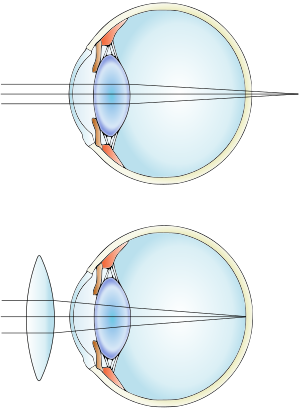Hyperopia
| Far-sightedness | |
|---|---|
| Synonyms | hypermetropia, hyperopia, longsightedness |
 |
|
| Far-sightedness lens correction | |
| Classification and external resources | |
| Specialty | Ophthalmology |
| ICD-10 | H52.0 |
| ICD-9-CM | 367.0 |
| DiseasesDB | 29644 |
| MedlinePlus | 001020 |
| MeSH | D006956 |
Far-sightedness, also known as long-sightedness and hyperopia, is a condition of the eye in which light is focused behind, instead of on, the retina. This causes close objects to be blurry, while far objects may appear normal. As the condition worsens, objects at all distances may be blurred. Other symptoms may include headaches and eye strain. People with hyperopia can also experience accommodative dysfunction, binocular dysfunction, amblyopia, and strabismus,
The cause is an imperfection in the eye: often when the eyeball is too short, or the lens cannot become round enough. It is a type of refractive error.
Correction is usually achieved by the use of convex corrective lenses. For near objects, the eye has to accommodate even more. Depending on the degree of hyperopia and the age of the person, which directly relates to the eye's accommodative ability, the symptoms can be different.
Far-sightedness primarily affects young children, with rates of 8% at 6 years and 1% at 15 years.
The signs and symptoms of far-sightedness are blurry vision, headaches, and eye strain. The common symptom is eye strain. Difficulty seeing with both eyes (binocular vision) may occur, as well as difficulty with depth perception.
As hyperopia is the result of the visual image being focused behind the retina, it has two main causes:
Far-sightedness is often present from birth, but children have a very flexible eye lens, which helps make up for the problem. In rare instances hyperopia can be due to diabetes, and problems with the blood vessels in the retina.
A diagnosis of far-sightedness can be made via a slit-lamp test which examines the cornea, conjunctiva, and iris.
...
Wikipedia
